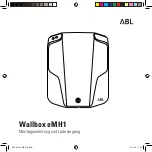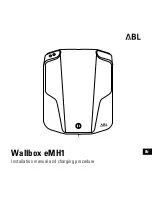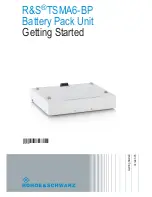
8
S A F E T Y I N S T R U C T I O N S
Portable Use with DC Clamps for In-Vehicle Battery
Maintaining Safety Precautions
16.
FOLLOW THESE STEPS WHEN BATTERY IS INSTALLED IN A VEHICLE. A SPARK
NEAR BATTERY MAY CAUSE BATTERY EXPLOSION. TO REDUCE RISK OF A
SPARK NEAR A BATTERY:
CAUTION
a. Position AC and DC cords to reduce risk of damage by hood, door or moving engine parts.
b. Stay clear of fan blades, belts, pulleys and other parts that can cause injury to persons.
c. Check polarity of battery posts. POSITIVE (POS, P, +) battery post usually has a larger diameter
than the NEGATIVE (NEG, N, –) post.
d. Identify if you have a negative or positive grounded vehicle. This can be done by identifying
which battery post NEGATIVE (NEG, N, –) or POSITIVE (POS, P, +) is connected to the
chassis.
e. For a negative grounded vehicle: connect the RED POSITIVE (POS, P, +) cable clamp or ring
terminal first to the positive post of the battery, then connect the BLACK NEGATIVE
(NEG, N, –) cable clamp or ring terminal to the vehicle’s chassis. Do not connect the BLACK
NEGATIVE (NEG, N, –) cable clamp to metal fuel lines or anywhere in proximity of the carburetor
or the battery itself. Connect to a heavy gauge metal part of the frame or engine block.
f. For a positive grounded vehicle: connect the BLACK NEGATIVE (NEG, N, –) cable clamp or
ring terminal first to the negative post of the battery, then connect the RED POSITIVE
(POS, P, +) cable clamp or ring terminal to the vehicle’s chassis. Do not connect the RED
POSITIVE (POS, P, +) cable clamp to metal fuel lines or anywhere in proximity of the carburetor
or the battery itself. Connect to a heavy gauge metal part of the frame or engine block.
g. Connect charger AC supply cord to a properly grounded fault protected electric outlet.
h. When charging is completed always disconnect AC power, remove clip from vehicle
chassis and then remove clip from battery terminal.
7
S A F E T Y I N S T R U C T I O N S
Charger Location & DC Connection
14.
CHARGER LOCATION
CAUTION
a. Locate charger as far away from batteries as possible.
b. Never place a charger directly above a battery being charged; gases or fluids from battery
will corrode and damage charger.
c. Do not operate charger in an enclosed area or in an area with restricted ventilation in any way.
d. Never allow battery acid to drip on charger when reading electrolyte specific gravity
or filling a battery.
e. Do not set a battery on top of charger.
f. Do not install on or over combustible surfaces.
15.
DC CONNECTION PRECAUTIONS
CAUTION
a.Connect and disconnect DC output cables only after removing AC cord from electric outlet.
Never allow cables to touch each other.







































